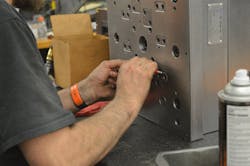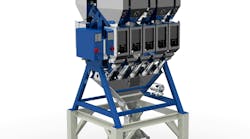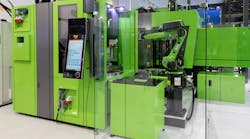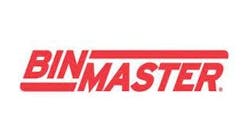By Karen Hanna
Inflation, high interest rates and supply chain disruptions have created uncertainty throughout the economy, but whatever the short-term outlook, one constant is clear: Finding workers will remain a challenge.
“We hear from businesses across every state and every industry that they cannot find the workers that they need,” said Stephanie Ferguson, director of Global Employment Policy & Special Initiatives for the U.S. Chamber of Commerce. “We have a shrinking workforce. Our largest generation, the baby boomers, are all reaching retirement age; all of them will be at retirement age by 2030. At the same time, we have a lowering birth rate. So, our workforce is just getting smaller, and that’s coupled with a labor-force-participation rate that has been declining for decades.”
Workforce experts cited a number of factors currently creating drag on the economy — including wars overseas and anxiety over this year’s elections. But those challenges — which might slow hiring for the time being — mask a reality employers will confront for a long time to come.
Statistics available from organizations like the Chamber and the U.S. Bureau of Labor Statistics (BLS), among others, show that the labor pool is just not deep enough — especially in light of workforce shifts set in motion by the COVID-19 pandemic. A Chamber report authored by Ferguson titled “Understanding America’s Labor Shortage” summarized the dilemma in late January: “We have a lot of jobs, but not enough workers to fill them. If every unemployed person in the country found a job, we would still have 2 million open jobs.”
“It’s a mess I don’t see going away,” said Dan Regovich, founder of AJ Augur Group LLC, a headhunter firm that provides services to the plastics industry. “The only way I see that employee shortage going away would be a massive, massive recession.”
Tight economy takes up the slack
For some manufacturers that have struggled for years to find workers, recent months might have provided an unwanted reprieve. Hiring has cooled.
According to the BLS, around 5.5 million people landed new, non-farming-related jobs in November — the fewest new hires since April 2020, as the pandemic’s initial shockwaves began reverberating throughout the economy.
“I’m seeing more people just not actively hiring. They would rather get someone promoted internally than hiring someone externally ... focusing on getting who they have to come to the next level,” said consultant Jorge Gomar, who works with a number of clients in the plastics industry as a senior client partner for Korn Ferry. “In some cases, I’ve seen some companies who have, unfortunately, let some people go, but I’ve seen more of those in the white-collar jobs.”
Workers, too, are nervous.
According to a survey of nearly 1,900 workers conducted in October by job-seeker resource My Perfect Resume, 78 percent of respondents expected a recession this year. Eighty-five percent expressed concern that they will lose their jobs this year.
But Gomar and other workforce experts say they expect the downturn to be minor. Employers, Gomar said, are merely “retrenching” and “rebalancing,” holding off on hiring till a turnaround he predicted will be underway by year’s end. Meanwhile, Bob Hersh, national managing principal of manufacturing for Grant Thornton’s New York and New England business advisory services, predicted the economy will make a “soft landing” by the second quarter.
According to the BLS, the number of people laid off from one month to the next has remained fairly steady; in November, manufacturers handed out pink slips to 103,000 workers, compared with 101,000 workers in November 2022.
Overall, around 1.5 million workers lost their jobs to layoffs in November.
Current economic conditions have contributed to what Gomar calls a “strange time.” He cautioned employers not to overreact.
“We’re not seeing a Great Recession type of situation. I look at my clients, they’re expecting a softening,” Gomar said. “Is that a soft recession? Or is that a soft landing? I don’t think anyone knows, quite frankly.”
“The temptation is layoffs. ... What I would say is, ‘Remember your lessons from the pandemic, that, if you cut too much, you’re going to lose a lot of that know-how, and you’re going to pay, unfortunately. You’re going to be losing productivity, you’re going to be losing safety, you’re going to be losing quality,’ ” he said.
The economic malaise has given some employers pause, said Kathleen Quinn Votaw, CEO of TalenTrust, a strategic recruiting and human capital consulting firm that works with manufacturers.
With less demand for labor when she spoke in December, manufacturers for once have had the luxury to be a bit choosier.
“I see more careful consideration about who we’re going to hire. We’ve had open positions canceled. They’ve just decided, ‘Man, we’re not going to hire that person.’ ... There’s a lot of deferment to the first quarter. Like, ‘Let’s wait till after the holidays,’ ” she said.
Caught in a numbers crunch
Amid the doldrums, Regovich still hears from manufacturers desperate to enlist help to find workers in positions below the levels his search firm actually recruits.
“Companies can’t even find people, so [they say]: ‘We could grow so much more, but we can’t find people.’ That’s primarily the main manufacturing floor. I don’t do those type of decisions, but I hear about it all the time. I get calls all the time: ‘Hey, Dan, we have these processor positions on the floor. We need help,’ ” he said.
December’s unemployment rate of 3.7 percent might provide the impression that nearly everyone’s working, but seasonally adjusted pandemic- and post-pandemic-era labor force participation rates are at a level last seen over sustained periods during the disco era, when the employment rate was much higher.
The participation rate, which measures the percentage of noninstitutionalized civilians age 16 and up who are working or actively looking for work, hit its high-water mark of 67.3 percent in the early months of 2000. But since then, it’s mostly steadily declined, eventually cratering at 60.1 percent — not much higher than 1950s-era levels.
It’s now 62.5 percent — a low point reminiscent of the stagnation of the late 1970s.
According to the Chamber report, had the rate remained at its February 2020 level, about 2.2 million more people would be working.
It notes that inflation has depleted some people’s savings, making them more apt to return to the workforce.
“Benefits that individuals cashed out on to retire early may not be lasting as long as they had anticipated ... ” Ferguson said. “So, it could certainly move the leverage back into the hands of employers to attract and retain talent, but holistically the worker shortage is going to remain a challenge.”
She said she expects the percentage of people participating in the workforce to continue to fall.
Off the clock
The pandemic struck just as the workforce was already entering a transition period, with the demographic of retirement-age people — age 65 or older — projected to increase from 17 percent of the population in 2020 to 22 percent by 2040.
That group accounts for a big segment of the population that has since left the workforce.
More than 4.1 million Americans will retire every year through 2027.
“If you look at the age of the workforce, in general, historically, it’s been sort of like a pyramid type of shape, and now it’s sort of like a snake eating ... there’s a bubble. It’s got to be rectified over time, and it will be rectified over time, but it’s not a short-term demographic issue,” Grant Thornton’s Hersh said. “The demographics are actually kind of working against us right now.”
Fears over the pandemic, access to increased savings — even new opportunities available through social media and the gig economy — have opened the door to a worker exodus that’s only now beginning to slow.
“People are finding more dynamic ways to stay home because of those bolstered savings accounts. .... We saw that many families restructured themselves from two-income families to single-income families. We also know that Americans are finding new ways to make money,” Ferguson said.
According to the Chamber report, “In 2022, more than 50 million workers quit their jobs, following the 47.8 million who did so in 2021. In 2023, this trend has gradually subsided, with 30.5 million workers resigning as of August.”
Compared with February 2020 workforce levels, 1.7 million workers remain unaccounted for, according to the Chamber.
“There are many aspects to the declining labor force participation rate. We just don’t understand the full scope of why it’s happening or how to solve it,” Ferguson said.
The hardest-hit industries include: mining; logging; education and health services; government, professional and business services. Durable goods manufacturing — a sector with just 54 available experienced workers for every 100 open jobs — is right behind, according to Ferguson.
Overall, there are about 1.4 openings for every available worker, according to BLS statistics.
Making do
Finding workers amidst the shortage requires some creativity. Pay, benefits, training and community outreach efforts all play a role for companies vying for the best workers from a shrinking labor pool.
“Folks are more and more looking for compensation aside from wages, so PTO, health benefits, fertility benefits, pet insurance,” Ferguson said. “We seem to believe these things are sometimes not conventional, but they’re a great tool to get somebody into your workforce, and of course, company culture is a great way to retain talent.”
One buzzword often bandied about by workforce experts is flexibility. Once a luxe perk, flexibility became essential during the pandemic, and it’s remained a key benefit for workers and employers alike.
Challenges in accessing childcare, in particular, have kept some people from returning to work.
The experience of one demographic — mothers — illustrates what can happen when outside pressures become too much. According to the Chamber report, “In the spring of 2020, 3.5 million mothers left their job, driving the labor force participation rate for working moms from around 70 percent to 55 percent.” While some now are back in the workforce, 27 percent have indicated that caregiving demands make returning to work difficult.
According to the National Association of Manufacturers, 46.8 percent of manufacturing executives who responded to a survey in 2023 reported that their company was offering flexible scheduling to workers.
That trend reflects challenges in getting workers to fill onsite jobs.
“In-person jobs often are the most difficult to fill. This is, of course, a long-lasting symptom of the pandemic and people being able to work from home,” Ferguson said.
Steve Rogers is one molding plant owner who has seen the shift from a traditional workaday mentality firsthand. Some of his workers at Anchor Plastics Inc., Golden Valley, Minn., pocket extra money from side hustles, such as providing rides or delivering meals.
“Young people today are smarter,” said Rogers, the CEO, president and owner of Anchor Plastics. “They figured out how to live off 20 hours and 30 hours [of work a week].”
Workers’ interest in an array of benefits is evolving, Rogers observed.
He said he’s trying to give them what they want — even if that means restructuring everything.
“We’re in the process of evaluating all of our benefits right now and saying, can we just go to sort of a cafeteria [menu system] where instead of [paying] $10,000 per employee ... for a benefit which nobody uses, if I just take $10,000, which is my benefit cost to my employees ... and saying, ‘Here, if you want to use 10 grand to go pay for schooling, or 10 grand to go pay for insurance, or 10 grand to go pay for ... whatever?’ ” Rogers said.
Ready to pay a premium
But traditional benefits — including pay — still matter.
According to an analysis by consulting firm Deloitte, between the first fiscal quarters of 2022 and 2023, hourly earnings increased 4 percent. The Chamber’s America Works Data Center reported slightly different findings — with increases in the summer of 2021 and spring of 2022, before pay levels stabilized in 2023.
“Workers are certainly leveraging higher wages in order to either find new opportunities or stay with current employers,” Ferguson said.
And they’re expecting more to come — according to the Deloitte analysis, 75 percent of people surveyed are convinced they’ll see raises this year, too.
Not that all employers have gotten the memo.
When it comes to initial offers, Regovich — who mainly provides services to fill positions paying around $80,000 and up — said companies sometimes fall far from the mark. In one recent case, a client low-balled an engineering manager candidate he had recruited by about $50,000.
Regovich said relocation expenses also can present a stumbling block for companies that have not bothered to hammer out proper policies.
“And it goes back and forth and back and forth, and you start building some bad blood between the candidate and the hiring company,” he said.
While companies are realizing they must make adjustments in their offers, some still have a way to go.
“I think it’s people having sticker shock,” he said.
Replacing experience
The cost of worker attrition over the past few years is evident in other ways, too. Sapped of experience and institutional knowledge, manufacturers might see reduced productivity and even safety lapses. However, in offering training opportunities to offset those problems, they can provide a reason for workers to stay.
“A great tool for filling gaps in your business is to invest in the reskilling and upskilling of the talent that you already have in-house,” Ferguson said. “That benefits not only the employer for securing the workforce of the future, but, of course, in turn, it makes your employees feel that they’ve been invested in and allows them to stay and thrive in the business.”
The experience that companies have lost over the past few years is starting to catch up with them, Korn Ferry’s Gomar observed. While they might drag their feet on some job offers as the economy resets, companies that have lost employees with critical skill sets and abilities must backfill those positions.
“They lost a lot of knowledge and skill sets through the pandemic,” Gomar said. “When they’re making those hires, they’re critical hires. They’re hires of people who have the know-how around how to bring your safety, how to bring your quality, back to where it needed to be, how to improve your Lean Six Sigma productivity.”
He said manufacturers should redouble their efforts to bring their current workforce up to speed.
Employers also should equip their workers to move up, according to Ferguson and other experts.
“We need to step back a little bit and really focus on the new workforce that we brought in, the newer ranks. ... Let’s make sure we get them to that baseline where we used to be,” Gomar said.
Preparing for the rebound
Returning to the baseline will mean tackling workforce challenges, even at a time when hiring seems less critical. As workforce experts note, the gap between the number of open positions and the people available to fill them isn’t going to close — so employers can’t take a breather from trying to address it.
In November, the number of job openings hit its lowest level since March 2022, but the 8.8 million unfilled positions still exceed by millions the numbers recorded in the first months of the pandemic and in the years before the crisis. Manufacturing companies had 547,000 unfilled jobs — including 383,000 in the durable-goods production sector, according to November preliminary figures from the BLS.
But a rebound in job openings is coming — and workforce experts say manufacturers better be ready for it.
As recruiter Regovich said, “There’s still people holding off on hiring, because they’re still uncertain on what’s going on with the economy. They’re not sure where it’s headed, but I do hear more optimism.”
To prepare for labor disruptions that are sure to come, manufacturers will have to find ways to become more productive with fewer workers.
Those who can’t adjust will fall behind, Korn Ferry’s Gomar said.
“That next baseline would be really thinking through some of these new applications around automation, technology, digitization and the workforce ... and having the right skill sets to be able to manage those kind of situations,” he said. “I would say if there’s a company that is not thinking about that right now, they should, because what’s going to happen is I think there’s going to be step-changing productivity in the next couple of years and you want to make sure you set your foundation now.”
He warned: “Don’t wait until you’re not competitive.”
Whether a company has positions to fill now or not, it should be constantly angling to be sure its labor pool is full, Quinn Votaw said. If not, it could be conceding access to the best workers to its competition.
“Our employees are also being recruited by another employer, and, if you don’t provide for them, somebody else will,” Quinn Votaw said.
“I say never stop recruiting for the best available talent for your company.”
Contact:
AJ Augur Group LLC, Mentor, Ohio, 440-357-7600, www.ajaugur.com
Deloitte, New York, 212-492-4000, www2.deloitte.com
Grant Thornton LLP, Boston, 617-723-7900, www.grantthornton.com
Korn Ferry, Dallas, 214-665-3018, www.kornferry.com
TalenTrust, Denver, 303-838-3334, www.talentrust.com
U.S. Chamber of Commerce, Washington, 202-659-6000, www.uschamber.com






